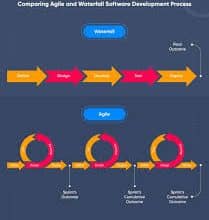It makes sense for businesses to concentrate their advertising budgets on the digital sphere because 95% of global consumers shop online. According to Statista, the US alone spent more than $200 billion on digital advertisements in 2022. Worldwide spending on Internet advertising is also anticipated to increase in the coming years.
This has led to different advertising models being created as a result of advertisers’ searches for various means of efficiently reaching their target audiences. Pay-per-click (PPC) or cost-per-click (CPC) ads are among the most popular of these. Therefore, it can be difficult and overwhelming to select the best payment strategy for an online advertising campaign. Particularly when a company is attempting to make the most of its financial resources and avoid spending excessively on advertisements too early in the campaign.
Pay-Per-Click (PPC) is a digital marketing model where the advertiser pays a fee each time one of their ads is clicked.
Cost-Per-Click, or CPC, is a key metric to take into account when calculating the overall cost of customer acquisition because it measures how much it costs a company to bring a customer to its website.
In this article, you’ll learn why CPC is important, how to calculate it, and its importance in the marketing and advertising worlds.
What Is CPC?
Cost per click (CPC) is a method of generating online advertising revenue in which the advertiser pays the publisher according to how frequently users click on display ads.
In other words, CPC refers to the cost an advertiser pays anytime an ad is clicked in an advertising campaign. According to this viewpoint, the CPC is a crucial metric for advertisers. A low CPC is preferable because it will require a company to spend less money to achieve its marketing objectives.
Additionally, it is the sum that the advertiser pays for each time their PPC ad is clicked on a platform like Google AdWords or Bing Ads. The highest bid, quality rating, and ad rank of competing advertisers who placed bids for the same keyword are some of the variables used to calculate the CPC. It is a crucial metric because clicks and costs can add up quickly. If the CPC is too high, advertisers won’t be able to realize a return on their advertising investments.
It will be helpful for you if you pay attention to the CPC advertising formula to comprehend what CPC is in digital marketing.
CPC= Cost to the Advertiser / Number of Clicks.
Note that:
- Cost per click is a method used by websites to charge advertisers for their services.
- To match content publishers with advertisers, third parties are frequently used.
- Lastly, one of the most popular cost-per-click platforms is Google’s AdSense program.
How Does CPC Work?
Cost per click is a popular method used by advertisers when running a campaign on a daily budget. The ad is automatically taken out of rotation on the website for the balance of the billing period once the advertiser’s budget is met. For instance, a website charging an advertiser $.05 per click would charge $50 for 1,000 click-throughs.
The majority of publishers use a third party to connect them with clients. The biggest of these is Google Ads, which operates on the Google AdSense platform.
How Much Does a CPC Cost?
Through a bidding system, a click only costs what you are willing to pay for it. On Google Ads, for instance, you could place a maximum bid of $1 per click. The system uses algorithms to evaluate your ads and only ever charges you the amount you bid. There are some restrictions, though.
Higher ad quality scores are rewarded by the Google Ads system with discounts for advertisers. The content of the advertisement and its relevance to the searched terms are what contribute to this score. The lower your bid, again adjusting for other factors considered by the platform, the worse off your ad will be in position.
How Is CPC (Cost Per Click) Calculated?
To calculate the cost per click, a formula may be used. One of the most widely used methods to determine your CPC is CPC = Cost to the Advertiser / Number of Clicks.
Furthermore, a bidding process is used by some publishers or platforms, including Google Ads, to determine their rates. For instance, Google Ads asks you to choose the highest click-through rate you’re willing to accept. When your ad is clicked, the Google platform uses Ad Rank thresholds to calculate the actual cost.
Consequently, because the platform ranks your bid, ad quality, position, user signals, search topics, and related auctions before determining the cost per click, your cost can vary up to your maximum. Therefore, to increase click-through, you can even have Google automate the bids for you. Following that, the platform places your ad based on your maximum, with higher maximums resulting in higher placement on the page.
What Elements Affect Your CPC?
As we’ve already mentioned, different publishers use various techniques to determine cost per click (CPC). Many of these calculations are performed automatically based on certain variables. These elements are:
#1. Maximum Bid
This refers to the maximum investment an advertiser is willing to make to determine the cost per click (CPC).
#2. Quality Score
The quality score describes the platform’s ad relevance. The higher the quality score, the better, as Google Ads wants to display high-quality advertisements. The relevance of the keyword, the caliber of the landing page, and the click-through rate (CTR) are some of the other ad features that go into determining the quality score.
#3. Ad Rank
An advertiser has little control over the ad rank as a metric. The quality of the ad, the amount of the bid, as well as other external factors—like user intent or the context of a person’s search—are used to determine the ad rank.
Types of CPC Ads
Many digital marketing campaigns use cost-per-click (CPC). These campaigns may include text ads, image ads, video ads, and other types of advertisements common to social media platforms. While some of these ad formats are only used by a few networks, others are employed by numerous publishers.
The following eight ad types support the CPC model:
#1. Text Ads
Text alone is the foundation of text ads, and they do not use any other media. Even though they have a straightforward design, these ads are effective and well-liked when used in paid search campaigns. The Google Display Network (GDN), for instance, is the most well-known network and reaches more than 95% of internet users. Every second, Google handles over 120,000 searches. Given these figures, it is understandable why advertisers continue to vie for the top search engine rankings.
#2. Shopping Ads
Google Shopping Ads allows retail businesses to promote landing pages and enables businesses to advertise specific product listings. When a user performs a specific product search, shopping ads show up in the search results. Because of this, retail customers can simply click on a relevant ad result without having to complete a more involved customer journey.
#3. Image Ads
Image ads are used to capture users’ attention and encourage clicks. These ads make use of visual elements. Information about products, companies, or special offers may be included in image ads. They could be social media ads, display ads, or banners. All CPC image ads have a link that directs viewers to a landing page.
#4. Video Ads
Before, during, or after a user streams a video, video advertisements are usually played. In addition to other video-sharing websites, YouTube also offers video advertisements. Because they make it simple for the viewer to interact with the advertisement, these types of advertisements have grown in popularity recently because they allow the user to click on a link to go to the promoted website when used with CPC.
#5. Twitter Ads
Promoted tweets are essentially Twitter CPC ads. These advertisements give advertisers the chance to spread the word about their tweets while also directing users to a specific landing page.
#6. Facebook Ads
Facebook’s $100 billion in ad revenue in 2021 serves as further evidence of the success of social media marketing campaigns. Facebook is a well-liked marketing platform with 2 billion daily users. Facebook ads are frequently used in conjunction with a pay-per-click (PPC) option and come in a variety of formats (boosted posts, image ads, video ads, etc.).
#7. Instagram Ads
Instagram also offers the option to promote a profile or a story in addition to boosting posts. In the case of a story promotion, accounts with a sizable following can insert links and direct users to the advertiser’s website, which is hosted outside of the platform.
#8. LinkedIn Ads
The business-focused social media platform LinkedIn allows users to run a variety of social media advertisements, including text ads, dynamic ads, video ads, and sponsored content (boosted posts). For each of their campaigns, advertisers on LinkedIn are free to select a goal. They will pay per click for some of these objectives, like increasing website traffic (PPC). These advertisements can either be image or text ads on LinkedIn.
What Is a Good CPC?
A good CPC (cost per click) rate is based on your return on investment. You should aim to make at least $2.50 back for every $2 spent (at a minimum). The CPC rate of $2 for every $1 spent would be very favorable.
What Does a High CPC Mean?
A high CPC indicates that you are paying a lot for each click on your advertisement. This may be a sign that your target audience is not responding to your ads or that you need to alter your targeting approach. In contrast, a low CPC indicates that you are receiving a high volume of clicks for your investment.
Can you make money with CPC?
Pay-per-click revenue can be earned through advertising networks like Google AdSense. Only after signing up with an ad network can website owners embed the code they provide on their pages. One of the best options is Google AdSense, but after you register, it needs to be approved.
How Much Can I Make on CPC?
As of 2023, the average CPC salary in the United States is $60,000, but the typical range is between $50,000 and $68,000. Salary ranges can vary significantly depending on several crucial factors, including education, credentials, additional skills, and the length of time you’ve been working in a given field.
Is Low CPC Good or Bad?
Yes, it is good for the advertiser the more clicks they can accommodate within their budget, the more potential leads they can generate. Since you will make a significant profit over your investment, it also guarantees that your ROI will be high.
What Does a Low CPC indicate?
In general, a lower CPC suggests that your marketing budget is working harder because it generates more clicks per dollar spent. On the other hand, pay-per-click is a marketing strategy where advertisers pay a predetermined sum for each ad click, and the terms CPC and PPC are often used interchangeably.
Is It Better To Have A High Or Low CPC?
A low CPC is what you should strive for. In marketing, a low CPC enables you to allocate more clicks for your budget, resulting in more potential leads. Because you will make a significant profit over your investment, it also guarantees that your ROI will be high.
- SEO ADVERTISING: Meaning, How It Works, Techniques (Detailed Guide)
- DISRUPTIVE ADVERTISING: Meaning, Examples & Reviews
- DIGITAL ADVERTISING: Meaning, Examples, Strategies & Alliance
- BEST DAILY PLANNER APP: Best Free Apps to Install in 2023[IPHONE & Android]
- BOOKKEEPING BUSINESS: What Is It, How to Start One, Cost & Salary
- WHAT IS PAYROLL: What Is It, Tax, Deduction, Adp & Compliance Practitioner






